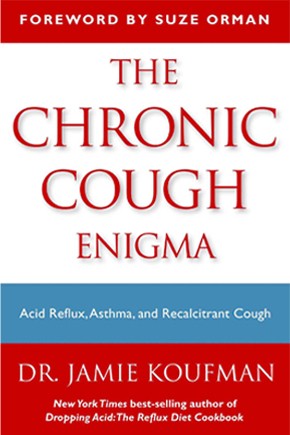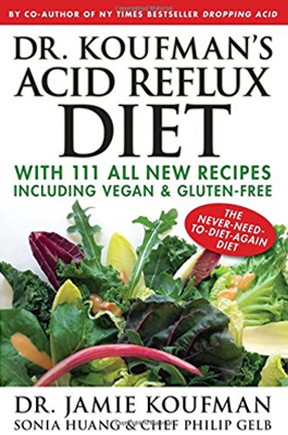LPR aka Respiratory Reflux: Why Doesn’t My Gastroenterologist Know About This?
At-A-Glance
- The GI model of acid reflux disease is wrong. First, most reflux is not about heartburn; second, sticking scopes down people (endoscopy) is NOT how reflux is diagnosed; and third, reflux is about pepsin. That’s why purple pills like Nexium and Prilosec prescribed by GIs have never cured a single case of reflux.
- In 1975, the Olympus Corporation began marketing GI endoscopes, and a new industry was born. Since then, no other medical specialty has grown like GI. In 1975 there were 700 of them, and today there are 25,000 GIs (making an average $485K per year). Do the math; that’s over $12 billion per year, and for what? Sedated GI endoscopy is a hapless and harmful multibillion dollar business that is literally killing people: Time for change.
- GIs hijacked reflux with the mantra reflux is heartburn, and heartburn is reflux; it’s esophageal, and we own it. The GI made himself the go-to doctor for reflux, but without understanding LPR, a far bigger problem than “the GI heartburn business model.” Consequently, other specialties that confront patients with respiratory diseases remain in the dark, because as consultants for LPR, that is respiratory reflux, GIs are worthless.
- If one looked at the cost-to-benefit ratio for EGD, it would low. So it’s time to embrace the new silent nocturnal respiratory reflux paradigm. In doing so, we might dramatically increase quality of care, benefiting as many as 100 million Americans, while simultaneously reducing healthcare costs by hundreds of millions of dollars.
GI Specialization and Reflux History as Told by a Laryngologist
I am a pioneering laryngologist, not a GI, and I have studied respiratory reflux as my life’s work. For almost fifty years, I have watched and participated in the evolution of medical specialties, as well as the downward spiral of the American diet and lifestyle, which IS associated with skyrocketing acid reflux in the population, particularly and mostly respiratory reflux (LPR).
There is no better example of the failure of the healthcare industry than the case of acid reflux and the GI specialist. But I have skin in the game, and give me credit for being the biggest critic of GI for decades. Bottom line: Following the recognition of important biological patterns from treating thousands of patients, I changed the way I provide medical care to cure reflux. and I want to help you, too. And sorry, there is no magic bullet for curing reflux; it’s all about healthy diet and lifestyle.
Make no mistake about it, this story is personal; I’m sharing some never-before-told background here. In 1981, I first suspected that reflux could affect the larynx without patients having symptoms of GERD (gastroesophageal reflux disease), those symptoms being heartburn and indigestion. I soon grew confident that reflux into the throat was a significant problem, so I was delighted to learn that GIs at my institution had a reflux testing system. It was ambulatory 24-hour pH-monitoring (pH-metry), which involved placing a catheter with a pH (acidity) meter in the esophagus, connected to a minicomputer that could record the pH (acidity) data almost continuously.
The GI lab was under the auspices of a gastroenterologist who rose to become the key opinion leader in the GI “reflux field.” When I presented my experience with LPR to the GI research group, they dismissed the idea that reflux could rise up into the throat. So, I had to convince a research fellow to let me use the GI pH-metry to do reflux testing on my patients, but in this case, I placed a pH catheter in the pharynx (throat) as well as in the esophagus. (We connected the two pH probes by dental rubber bands, and the patients wore two pH-measuring boxes, one for each pH probe.)
Eureka! LPR proved to be a new entity very quickly. Although I wrote a few early publications with the GI, by 1986 I decided to open my own reflux testing laboratory and become independent from them. It was the world’s first lab that tested for acid in both the esophagus and pharynx (throat) simultaneously using new technology. The company that produced the pH catheters agreed to make me custom, double-probe designs that simultaneously measured pH in the throat and esophagus.
By the time my Trilogical Thesis was published, my Magnum opus, the GI leaders from my past had become LPR-deniers. By 1999, I had published enough to put LPR on the medical map. Perhaps it was that year, the stake also impaled the GI heart; because that’s when I began performing Transnasal Esophagoscopy (TNE); see also my old TNE website.
As an obviously superior and safer technology compared to GI sedated upper endoscopy (EGD), TNE was performed with the patient awake, without anesthesia, and the patient could walk out the door immediately after completion of the procedure. TNE was/is better, cheaper, and more accurate than GI endoscopy.
GIs may have started circling the wagons when I first published an article using pH-monitoring for LPR in an ENT journal (1989); but for certain, collaboration ended with the emergence of TNE in the early 2000s. On several occasions, a prominent GI reportedly said to colleagues, “Jamie Koufman should not be doing esophagoscopy.”
Why Does My GI Know Nothing About Respiratory Reflux (LPR)?
Answer: GI specialists don’t want to know about it. To recognize respiratory reflux (LPR) would threaten the “heartburn business model,” and that’s how GIs make a living. And what does that mean? Everyone with reflux who visits a GI endoscopist gets sedated endoscopy and then treatment with a PPI.
We have previously reported that 81% of people with respiratory reflux (LPR) have normal esophagoscopy examinations. Furthermore, in patients coming to see me having already had an endoscopy by a GI specialist, 90% of them had normal exams. So, then what’s the point of sedated endoscopy?
In 1975, the Olympus Corp began selling new GI endoscopes and a new industry was born. No other medical specialty has grown like GI. In 1975, there were 700 of them, and today there are 15,500. It’s about money: The average GI makes almost $500,000 a year, about the same as specialty surgeons (see section ASCs below). .
In my opinion, sedated endoscopy is a hapless multibillion dollar business that actually kills people; since its beginnings in the 1970s, about 50,000 people have died. Endoscopes in hand, GIs hijacked reflux with the mantra reflux is heartburn; heartburn is reflux; it’s esophageal; and we own it. GIs made themselves “go-to” doctors for reflux. Without understanding LPR, which is a much bigger problem than GERD, “go-to” doctor became clueless and complacent. Other specialists who deal with respiratory diseases also remain in the dark because GIs act as consultants for them and offer no help at all regarding respiratory reflux.
An older GI acquaintance of mine (yes, I have few), shared a disturbing story with me. It was about a conversation at one of his faculty meetings … between three young endoscopy recruits in his group. The gist of this story? One of the young doctors said, “We know that endoscopy is toxic; so, let’s make as much money as we can in the next few years and then get out.” Toxic? Ouch!
In addition, many procedures are being performed that are not indicated. I have a patient, for example, with a wide-open, asymptomatic (no dysphagia, never had any difficulty swallowing) Schatzki Ring. Despite this, her GI brought her in for an endoscopy and dilation twice a year. Indications for these procedures are established, but are not very strict and loosely followed.
Soon, I will write a post on TNE, and the role GI played in trying to bury this less-expensive, potentially competitive endoscopy technology by intentionally getting its Medicare reimbursement dramatically lowered.
Is There Value-Added by GI Endoscopy?
When one considers the cost-to-benefit ratio of GI endoscopy (EGD) for reflux, we find that it’s quite low. If every GI follows the same protocol with every patient – they get the same endoscopy followed by the same prescription for an acid-suppressant – what’s the value of doing the endoscopy procedure? As far as I can tell, there is no evidence that the results of GI endoscopy for reflux, especially LPR, change the approach to treatment at all, since every GI patient gets the same. Plus, the use of anesthesia for these procedures adds unnecessary risks for patients; it is reported that one out of 9,000 people die from anesthesia complications.
What about the “other end” of GI endoscopy – the colonoscopy? May I please have Cologuard instead! If you think you need to get colonoscopy, think again. Ask your primary care provider (PCP) if you can get the Cologuard Test instead of a colonoscopy. (It depends on your family history and some other variables; she or he will know if Cologuard is right for you.) It’s sure is a lot easier to mail out a sample of your poop than getting a colonoscopy, which also includes a miserable “bowel prep.”
Conflicts of Interest: Physician Ownership of Ambulatory Surgery Centers
Another issue around waste and conflicts of interest in gastroenterology is GI ownership of ambulatory surgery centers (ASCs), which provide the GIs who own them with “facility fees” that are much higher than reimbursement for performing the endoscopy procedures.
Many states require a Certificate of Need to open an ASC healthcare facility, but it doesn’t seem to be a barrier for GIs. More than 30% of all ASC cases are GI cases, and GIs own 22% of all ASCs, more than any other specialty! They claimed, “physician ownership” of ASCs provides direct public benefits and decreased cost compared to performance of endoscopy in the hospital. Actually, they are no longer at “lower cost.” A GI can make over $1 million per year from owning an ASC, which represents a MASSIVE conflict of interest if that’s where they do their endoscopy procedures!
Are GI-owned ASCs in violation of the Stark Law? The Stark Law prohibits physicians from referring patients for select designated health services to entities they have financial ownership in, and prohibits owners from providing financial incentives for referrals. One can avoid violating the Stark Law while still owning an ASC; however, it would be difficult for patients to know if their GI or other specialist had a financial stake in an ASC, say, if it were incorporated in the name of a family member or business associate.
We don’t need gastroenterologists performing expensive routine screening exams, especially sedated endoscopy in cozy for-profit ACSs, when effective alternatives exist at lower cost. If you can find an experienced doctor who does TNE, and your PCP says Cologuard is okay for you, then say goodbye to your GI. In the future, we should train primary care physicians to perform screening endoscopies with the TNE technology.
When It Comes to Reflux, Gastroenterologists Are in the Stone Age
Adapting our approach to medical care should be normalized as we gather new clinical evidence. An example occurred a few years ago, when the indications for mammography were changed. It used to be recommended that every woman have an annual mammography screening. Today, mammograms are recommended every two years for women over 55. The change was based upon evidence from years of clinical data. This updated screening schedule saves money without compromising care.
Regardless of any possible healthcare reforms in the works, GI endoscopy procedures must again come under the scrutiny of Medicare (CMS), particularly the indications. In addition, GIs’ ASC conflicts of interest must be brought forward into the light. I urge public health and economic experts to look at the data on GI endoscopy. I’ll be writing a future post about re-empowering PCPs and offering a new educational curriculum in Integrated Aerodigestive Medicine.
It’s time to embrace a new reflux paradigm that puts respiratory reflux (LPR) at its center; and this includes a better endoscopy method without risky anesthesia, i.e., TNE. Finally, I hope there will be engagement by the GI community in response to this post so we can continue this important discussion.










